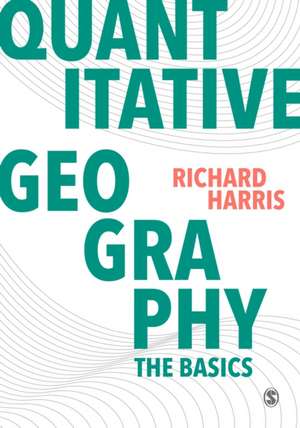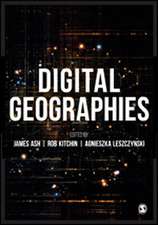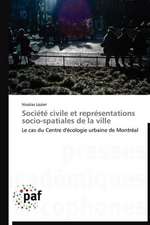Quantitative Geography: The Basics: Spatial Analytics and GIS
Autor Richard Harrisen Limba Engleză Paperback – 26 sep 2016
Quantitative Geography: The Basics is the perfect introduction for undergraduates beginning any quantitative methods course. Written in short, user-friendly chapters with full-colour diagrams, the book guides the reader through a wide range of topics from the basic to the more advanced, including:
- Statistics
- Maths
- Graphics
- Models
- Mapping and GIS
- R
Preț: 310.23 lei
Nou
Puncte Express: 465
Preț estimativ în valută:
59.38€ • 64.52$ • 49.91£
59.38€ • 64.52$ • 49.91£
Carte disponibilă
Livrare economică 31 martie-14 aprilie
Livrare express 14-20 martie pentru 42.12 lei
Preluare comenzi: 021 569.72.76
Specificații
ISBN-13: 9781446296547
ISBN-10: 1446296547
Pagini: 328
Dimensiuni: 170 x 242 x 17 mm
Greutate: 0.61 kg
Ediția:First Edition
Editura: SAGE Publications
Colecția Sage Publications Ltd
Seria Spatial Analytics and GIS
Locul publicării:London, United Kingdom
ISBN-10: 1446296547
Pagini: 328
Dimensiuni: 170 x 242 x 17 mm
Greutate: 0.61 kg
Ediția:First Edition
Editura: SAGE Publications
Colecția Sage Publications Ltd
Seria Spatial Analytics and GIS
Locul publicării:London, United Kingdom
Recenzii
'Quantitative Geography: The Basics' delivers exactly what the title promises. An engaging overview of the field that makes a strong case that all geographers can and should be exposed to statistical methods, if they are to fully engage with the contemporary discipline, and to participate effectively in wider, number-saturated, public debates.
I like the pitch of this book because the reader is encouraged to think and use common sense when looking at statistical outputs and to be critical but not negative for the sake of it. Technical terms are explained, often with an analogy. Graphical presentation is covered in detail with examples of different ways of illustrating the same outputs so it is clear why choices help or hinder interpretation. Particular highlights are that using pie charts is a really bad idea and that the author has used parkrun data. However, as a founder and run director at Skipton parkrun, I must declare that my opinion is biased!
I very much like the idea of this book. As a quantitative-based lecturer in a school of geography I struggle to find texts on statistics that will hold students' interests as they often crave geography-motivated examples. It is useful to have access to a statistics text that explicitly focuses on quantitative geography. The content is laid out in a straightforward manner and is not overly mathematical. I would be happy to suggest the text to my students.
This is an important book. Rich Harris makes a compelling case for why fluency with data, its collection, analysis and interpretation, is essential for geographers and geography today. The text provides a platform that encourages students to engage with ideas about data - relevant for all students whether interested in social, cultural or, economic geography, or hydrology, geomorphology or biogeography. This is a valuable addition to any introductory undergraduate geography reading list.
A remarkably pedagogic and perfectly illustrated quantitative geography manual that will delight students of all levels as much as their teachers
I like the pitch of this book because the reader is encouraged to think and use common sense when looking at statistical outputs and to be critical but not negative for the sake of it. Technical terms are explained, often with an analogy. Graphical presentation is covered in detail with examples of different ways of illustrating the same outputs so it is clear why choices help or hinder interpretation. Particular highlights are that using pie charts is a really bad idea and that the author has used parkrun data. However, as a founder and run director at Skipton parkrun, I must declare that my opinion is biased!
I very much like the idea of this book. As a quantitative-based lecturer in a school of geography I struggle to find texts on statistics that will hold students' interests as they often crave geography-motivated examples. It is useful to have access to a statistics text that explicitly focuses on quantitative geography. The content is laid out in a straightforward manner and is not overly mathematical. I would be happy to suggest the text to my students.
This is an important book. Rich Harris makes a compelling case for why fluency with data, its collection, analysis and interpretation, is essential for geographers and geography today. The text provides a platform that encourages students to engage with ideas about data - relevant for all students whether interested in social, cultural or, economic geography, or hydrology, geomorphology or biogeography. This is a valuable addition to any introductory undergraduate geography reading list.
A remarkably pedagogic and perfectly illustrated quantitative geography manual that will delight students of all levels as much as their teachers
Cuprins
PART 1: ABOUT QUANTITATIVE GEOGRAPHY
Introducing Quantitative Geography
The Use and Abuse of Statistics
PART 2: FOUNDATIONS OF QUANTITATIVE GEOGRAPHY
Principles of Statistics (or, how statistics work)
Some Maths and Notation
Descriptive and Inferential Statistics
Statistical Testing, statistical significance and why they are contentious
PART 3: DOING QUANTITATIVE GEOGRAPHY
Data Presentation and Graphics
Mapping and GIS
Looking at Relationships and Creating Models
Multiple regression and geography
Analysing Geographical Patterns and Differences
An Introduction to R
Introducing Quantitative Geography
The Use and Abuse of Statistics
PART 2: FOUNDATIONS OF QUANTITATIVE GEOGRAPHY
Principles of Statistics (or, how statistics work)
Some Maths and Notation
Descriptive and Inferential Statistics
Statistical Testing, statistical significance and why they are contentious
PART 3: DOING QUANTITATIVE GEOGRAPHY
Data Presentation and Graphics
Mapping and GIS
Looking at Relationships and Creating Models
Multiple regression and geography
Analysing Geographical Patterns and Differences
An Introduction to R
Notă biografică
Richard Harris is Professor of Quantitative Social Geography at the School of Geographical Sciences, University of Bristol. He is the lead author on two textbooks about quantitative methods in geography and related disciplines: Statistics for Geography and Environmental Science(Prentice Hall, 2011) and Geodemographics, GIS and Neighbourhood Targeting(Wiley, 2005).
Richard¿s research interests are in the geographies of education and the education of geographers. He is currently Director of Bristol Q-Step Centre, part of a multimillion pound UK initiative to raise quantitative skills training among social science students, and has worked with both the Royal Geographical Society (with IBG) and Higher Education Academy to promote numeracy and to support the transition of students from schools to University.
Richard¿s research interests are in the geographies of education and the education of geographers. He is currently Director of Bristol Q-Step Centre, part of a multimillion pound UK initiative to raise quantitative skills training among social science students, and has worked with both the Royal Geographical Society (with IBG) and Higher Education Academy to promote numeracy and to support the transition of students from schools to University.
Descriere
The perfect primer and companion for undergraduate geography students approaching quantitative geography for the first time.
















